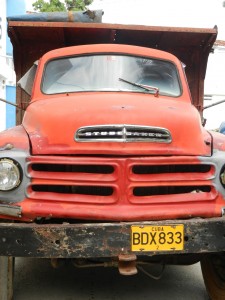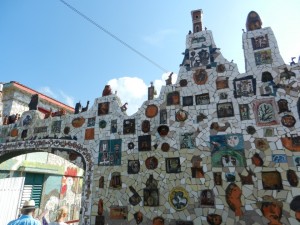
25 Feb TELLURIDE TO CUBA: A COUNTRY STUCK IN THE PAST
Editor’s note: Jane Shivers, former honcho marketing exec, is a part-time Telluride local and full time traveler with hubbie Bill Sharp. Jane plans a blog site of her own, but for now, she’s using our platform and we are grateful for her posts about the faraway places she visits.
 If your nervous system needs a break from technology, head to Cuba. Your iPhone will be useful only as an alarm clock. Internet? Nope. Your credit cards won’t work either unless you have one from Canada or Europe. Take a forced break from Groupon, Apps, and on-line sales at Amazon. If you tip with an American dollar, it won’t be easy for the recipient to use it so you will need to convert your dollars to Cuban Convertible Pesos, CUCs. When you convert your dollars they charge a 12% fee. Also take little soap bars because that is what the impoverished ask for on the street.
If your nervous system needs a break from technology, head to Cuba. Your iPhone will be useful only as an alarm clock. Internet? Nope. Your credit cards won’t work either unless you have one from Canada or Europe. Take a forced break from Groupon, Apps, and on-line sales at Amazon. If you tip with an American dollar, it won’t be easy for the recipient to use it so you will need to convert your dollars to Cuban Convertible Pesos, CUCs. When you convert your dollars they charge a 12% fee. Also take little soap bars because that is what the impoverished ask for on the street.
Not many Americans are traveling here yet, but it is getting a bit easier so move Cuba to the top of your travel list. Various organizations have travel permits and you can join a group to get proper visas and meet the requirements of the US and Cuban governments. Flights leave regularly out of Miami and less than one hour later, you step off the plane into a trip to 1959.
Leaving the airport and heading into the city, you’ll see cars your grandparents owned or your parents courted in. An occasional horse drawn cart goes by.
Tourism is the main industry in this country and tour buses abound full of Canadians, Germans, British, French, and Asian tourists. Tour guides talk about hotel companies and telecom companies and agriculture companies and what they mean is “the government”. That’s who gets the moola. The people get ration books so they can go to the company store and get their supply of beans, rice, flour and other staples. This is a clear lesson for young people about what is wrong with this form of economic policy so this is a good destination to take pre-teens, teens and college students.
While this is a poor country, Cuba is rich in smart, educated people, talented musicians and dancers, scrappy farmers, prolific and ambitious artists, experts in sustainability, ardent historic preservationists, and world- class car mechanics. Yet the big circular sports arena that tour guides point out on the way into Havana from the airport is dilapidated with window air conditioning units hanging out. Havana Vieja with its beautiful colonial architecture is either crumbling or newly restored as the country attempts to spruce up for the tourists. Streets and sidewalks need repair, as does much of the infrastructure. Leave your stilettos and high wedges at home.
The city itself, though, is delightful. There are interesting squares and churches; various bars where Hemingway drank or wrote including the famous Floridita; the historic and slightly tattered Hotel National with seaside grounds and photos of Frank Sinatra, the Mob, and other famous people on the walls of the bar; music emanates from street musicians, small bands in hotel lobbies, salsa groups in bars, and choral groups competing to win competitions in the Parque Central Hotel lobby. The performance of Danza Contemporanea de Cuba at the Gran Teatro is an extraordinary combo of classical ballet and modern dance. Small art galleries and art studios are tucked in courtyards, up above restaurants, and space sharing with shops selling Che Guevera hats, postcards and posters. A must-see is the home studio of artist Jose Fuster whose whimsical and intricate mosaics have influenced all his neighbors to do the same to their homes.
The Cuban people are educated, resourceful and pleasant. With no automobile parts available for the old cars, they fabricate parts out of whatever they can find. We saw a Studebaker farm truck that was still working. Entrepreneurial spirit abounds. From the cab drivers to the street entertainers, including a dog wearing clothes and sunglasses in a cart, to people who have opened restaurants in their homes, it is clear how strong the work ethic is and how creativity cannot be tamped down. They just don’t make any money. One engineer I met makes the equivalent of $20 a month.
Go and see for yourself. Root for the Cuban people. Support the artists because even though the La Corona cigar Factory tour and the Havana Club Rum Museum tours are not to be missed, you can’t bring cigars and rum home. You can bring back art and handicrafts duty free.
Be sure and venture to other parts of Cuba. One interesting place is Las Terrazas, a commune that combines tourism and sustainability. UNESCO designated the area a Biosphere Reserve in 1984. Nestled in a secondary forest planted on formerly deforested hills, the Cubans built terraces to prevent erosion; hence the Spanish name Las Terrazas. Sprinkled with white houses with red roofs, hotels and restaurants built with natural materials near ponds and gardens, the residents include working artists, and scrappy people like Maria and her son who have opened a coffee bar adjacent to her house. The Bean could benefit from some of her recipes. Nothing like rum mixed with Cuban coffee to give you a boost mid-morning.



Sorry, the comment form is closed at this time.